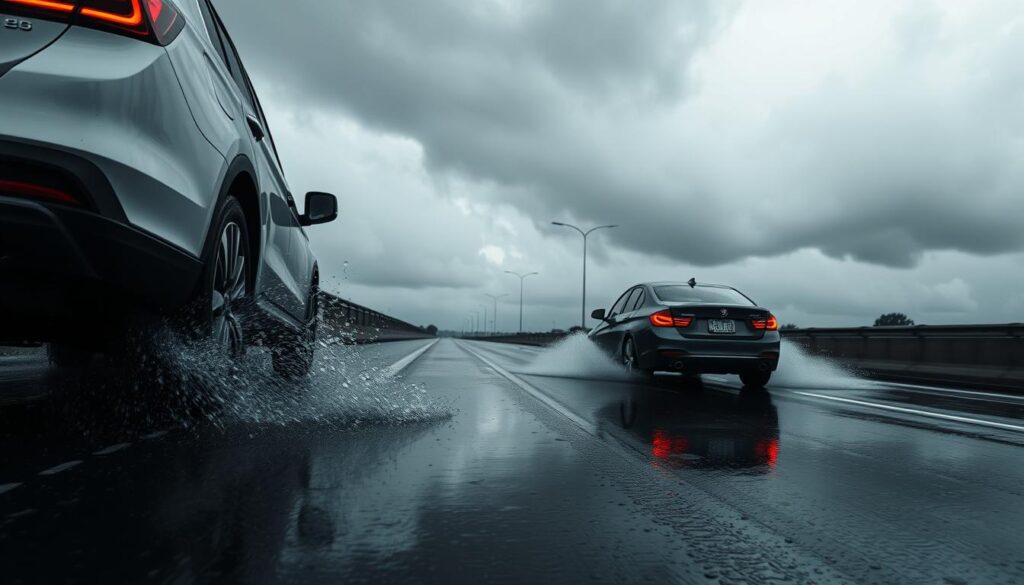Driving on the roads can be scary, but you can make it safer. This guide offers tips to help you avoid accidents. It teaches you how to stay safe and avoid dangerous situations.

This article talks about why road safety is important. It also covers defensive driving and how to handle bad weather. By following these tips, you can drive more safely. This helps you, your passengers, and everyone else on the road.
Key Takeaways
- Prioritize road safety and accident prevention as a responsible driver
- Understand the key factors that contribute to road accidents in the US
- Maintain your vehicle regularly to ensure optimal performance and safety
- Adopt defensive driving techniques to anticipate and respond to potential hazards
- Adjust your driving behavior to accommodate weather conditions and environmental factors
Understanding the Importance of Road Safety
Road safety is a big deal for everyone. Knowing the stats and reasons behind road accidents helps us stop them. It keeps drivers, passengers, and walkers safe.
Statistical Overview of Road Accidents in the US
In 2019, over 36,000 people died on US roads. Another 2.7 million got hurt. These road accident statistics show how serious the problem is.
The Impact of Safe Driving on Accident Prevention
Safe driving habits are key to preventing accidents. Following traffic rules, keeping your car in good shape, and driving defensively can really help. It can cut down on crashes and save lives.
Common Causes of Road Accidents
Knowing why accidents happen is important. Distracted driving, driving under the influence, speeding, and reckless behavior are big reasons. By understanding these accident causes, we can make our roads safer.
| Cause of Accident | Percentage of Accidents |
|---|---|
| Distracted Driving | 9% |
| Impaired Driving | 28% |
| Speeding | 26% |
| Reckless Behavior | 12% |
By focusing on road safety, looking at road accident statistics, and understanding safe driving, we can make our roads safer. This helps protect lives.
Essential Vehicle Maintenance for Safe Driving
Keeping your vehicle in good shape is key to safe driving. Regular checks and care for your car’s systems help prevent accidents. This keeps you and your passengers safe on the road. Here are some important maintenance tasks for every driver.
Tire Maintenance
Well-inflated tires are crucial for safe driving. Check your tire pressure often and follow the manufacturer’s advice. This improves your car’s handling, braking, and gas mileage.
Also, check the tire tread depth and rotate your tires when needed. This extends their life and boosts your safety on the road.
Brake System Inspection
Your brakes are the most important safety feature. Regularly check your brake pads, discs, and calipers for any problems. This ensures your brakes work well, reducing stopping distance and boosting your confidence on the road.
Lighting System Maintenance
Your lights, inside and out, are vital for seeing and being seen. Make sure your headlights, taillights, turn signals, and brake lights work right. This helps you stay visible to others, especially at night or in bad weather.
By focusing on these key maintenance tasks, you help make driving safer for everyone. A well-kept vehicle is a big part of road safety.
| Maintenance Task | Frequency | Benefits |
|---|---|---|
| Tire Pressure Check | Monthly | Improved handling, braking, and fuel efficiency |
| Brake System Inspection | Biannually | Reduced stopping distance and enhanced safety |
| Lighting System Inspection | Quarterly | Increased visibility and communication with other drivers |
“Proper vehicle maintenance is a proactive approach to road safety. By attractive care of your car, you’re taking care of yourself and those about you.”
Defensive Driving Techniques and Best Practices
Driving safely is more than just following traffic laws. It’s about using defensive driving techniques to stay safe. These methods can make your driving safer and help you avoid accidents.
Maintaining Safe Following Distance
Keeping a safe distance from the car in front is key. The “3-second rule” is a good guideline. It means you should be 3 seconds behind the car ahead. This gives you enough time to stop if needed.
Anticipating Other Drivers’ Actions
Good defensive driving means always watching the road and guessing what others might do. Being alert helps you spot dangers early. This way, you can dodge accidents by being ready for sudden moves by other cars.
Proper Speed Management
Driving at the right speed is crucial for safety. Stick to speed limits and adjust for road conditions. This helps you control your car better and react fast to unexpected situations. Fast driving increases accident risks and makes it harder to stay safe.
| Defensive Driving Technique | Benefit |
|---|---|
| Maintaining Safe Following Distance | Allows more time to react and brake in emergencies |
| Anticipating Other Drivers’ Actions | Enables proactive measures to avoid collisions |
| Proper Speed Management | Enhances vehicle control and reaction time |
Using these defensive driving tips every day can make your driving safer. It helps you avoid accidents and keeps everyone on the road safer.
Weather-Related Safety Precautions
Driving in rain, snow, and fog needs extra care and adjustments for safety. Whether it’s a sudden rainstorm or a snowstorm, knowing the challenges helps avoid accidents. This knowledge is key for safe driving in different weather.
Driving in the Rain
In rainy weather, slow down and leave more space between you and the car ahead. Wet roads make it hard to stop and turn. Also, watch out for hydroplaning, where your tires lose contact with the road.
Navigating Snow and Ice
Snowy and icy roads need a special driving style. Use lower gears, avoid sudden stops, and watch for black ice. Make sure your car has winter tires and carry an emergency kit.
| Weather Condition | Driving Precautions |
|---|---|
| Rain | Slow down and increase following distance Be mindful of hydroplaning Avoid sudden braking or acceleration |
| Snow and Ice | Use lower gears to maintain control Avoid sudden braking or acceleration Watch out for black ice Ensure proper winter tires and emergency kit |
| Fog | Slow down and turn on low-beam headlights Increase following distance Avoid sudden lane changes or braking |
Driving in Foggy Conditions
Foggy weather makes it hard to see. Slow down, use low-beam headlights, and leave more space. Avoid sudden turns or stops to stay safe.
Experienced by virtue of what to drive in various weather helps stay dependable. By being groomed and adjusting your forceful, you can prevent accidents. This create all trip safer, nevertheless the weather.

How to Avoid a Road Accident: Tips for Safe Driving
Driving safely is very important for everyone. By following safety rules, being ready for emergencies, and driving well, you can lower the chance of accidents. Here are some key tips to help you drive safely.
Basic Safety Protocols
Safe driving starts with obeying traffic laws. Always wear your seatbelt and follow speed limits. Never drive after using drugs or alcohol.
Stay focused on the road and around you. Avoid using phones, eating, or talking while driving. These things can take your eyes off the road.
Emergency Response Preparation
Being ready for emergencies is crucial. Make sure your car has a first-aid kit, fire extinguisher, and emergency tools. Also, know how to use your car’s safety features.
Learn how to handle a breakdown or accident. Knowing what to do can save lives.
Safe Driving Habits Development
Good driving habits help avoid accidents. Keep a safe distance from other cars. Anticipate what others might do and adjust your speed.
Check your blind spots and use turn signals. Being aware of your surroundings makes driving safer.
By following safety rules, being ready for emergencies, and driving well, you can greatly reduce the risk of accidents. Safe driving is not just for you; it’s for everyone’s safety on the road.
“The greatest weapon against stress is our ability to choose one thought over another.” – William James
Managing Distractions While Driving
Distracted driving is a big risk on the roads. It includes texting and driving, or adjusting the car’s entertainment systems. A brief distraction can lead to serious accidents. It’s important to keep your focus on the road.
Mobile phones are a major distraction. Texting and driving is especially risky. It takes your eyes, hands, and mind off driving. Use hands-free devices or don’t answer calls while driving.
- Avoid using your phone for tasks other than essential communication while driving.
- Consider turning off your phone or activating “Do Not Disturb” mode to minimize temptation.
- Pull over in a safe location if you need to use your phone for anything other than navigation.
Adjusting car systems like the radio or climate controls is another distraction. Do these tasks before you start driving or when parked safely. Don’t mess with them while moving.
“Distracted driving is a dangerous epidemic on America’s roadways. A moment’s lack of attention can have devastating consequences.”
Eating or drinking while driving is also distracting. It’s best to eat and drink before or after driving. This keeps your hands on the wheel and your eyes on the road.
Knowing and avoiding these distractions can make your drive safer. Always put the safety of yourself and others first on the road.
Night Driving Safety Guidelines
When the sun goes down, driving becomes more challenging. It’s important to stay alert and use the right techniques. Here are key tips for safe night driving, like using headlights right, improving visibility, and managing fatigue.
Proper Headlight Usage
Using headlights correctly is key to safe night driving. Make sure your headlights work well and are aimed right. Always switch between high and low beams to avoid blinding others.
Visibility Enhancement Techniques
There are ways to see better at night. Keep your windshield and mirrors clean. Also, use the night mode on your dashboard to reduce eye strain.
Managing Fatigue During Night Trips
Fatigue is a big issue at night. Get enough sleep before driving and take breaks to stretch. Eating healthy snacks and drinking water can also keep you alert.
By following these tips, you can drive safely at night. Always put safety first for yourself and others.
Highway and Interstate Safety Measures
Driving on high-speed highways and interstates can be tough. But, with the right safety steps, drivers can have a safe and smooth trip. This includes mastering merging, keeping the right speed, and more. Let’s explore how to stay safe on the road.
Merging Made Easy
Merging onto the highway can be scary. But, with the right techniques, it can be done smoothly. Keep a steady speed, check your blind spots, and signal your turn. This keeps you safe and helps others know what you’re doing.
Speed Management on the Highway
Driving at the right speed is key on highways and interstates. Follow the speed limit and adjust for the road conditions. Staying at a steady speed helps avoid accidents.
Navigating Heavy Traffic
Driving in heavy traffic can be tough. But, with smart strategies, you can get through it safely. Keep a safe distance, stay alert, and adjust as needed. Avoid sudden moves and stay calm to prevent accidents.
| Highway Driving Tips | Interstate Safety Measures | Merging Techniques |
|---|---|---|
| Maintain appropriate speed | Check blind spots before lane changes | Increase speed to match traffic flow |
| Avoid sudden braking or acceleration | Keep a safe following distance | Use turn signals to indicate intent |
| Be aware of surrounding vehicles | Adjust driving to weather conditions | Merge at the designated merge point |

By following these safety tips, drivers can feel confident on high-speed roads. Safe driving is a shared responsibility for our roads and communities.
Conclusion
In this detailed article, we’ve looked at key road safety points and how drivers can avoid accidents. We’ve covered safe driving, vehicle upkeep, defensive driving, and weather safety. These strategies help make the roads safer for everyone.
As we wrap up, remember that road safety is everyone’s duty. By following the safe driving tips in this article, you help lower accident rates. This benefits your community greatly. Always be careful and make safe driving a top priority.
The value of road safety is huge. By focusing on safe driving and staying updated on safety tips, we can all help make roads safer. Let’s all take steps to ensure our safety and the safety of those around us on the road.
FAQ
What are the most common causes of road accidents?
Road accidents often happen due to distracted driving, speeding, and driving while impaired. Reckless driving, poor vehicle maintenance, and bad weather also play a role.
How can proper vehicle maintenance help prevent accidents?
Keeping your vehicle in good shape is key. Check your tires, brakes, lights, and more regularly. This ensures your car is safe and reduces the chance of mechanical failures that could cause accidents.
What are the key defensive driving techniques to avoid accidents?
To avoid accidents, drive safely. Keep a safe distance from others, predict what they might do, and adjust your speed. Always be on the lookout for dangers.
How can driving in adverse weather conditions increase the risk of accidents?
Bad weather like rain, snow, or fog makes it hard to see and control your car. It’s vital to drive carefully and be extra cautious in these conditions.
What are some effective strategies for managing distractions while driving?
To avoid distractions, don’t use your phone or eat while driving. Set your music and GPS before you start. This helps you stay focused on the road.
How can proper headlight usage improve night driving safety?
Using your headlights right is crucial at night. Make sure they’re aligned and use high beams for dark spots and low beams for well-lit areas. This improves visibility and helps spot hazards sooner.
What are some key safety measures for highway and interstate driving?
On highways, drive at a steady speed and merge correctly. Be aware of your surroundings to handle heavy traffic safely. Keep a safe distance and be ready for sudden changes in traffic.










